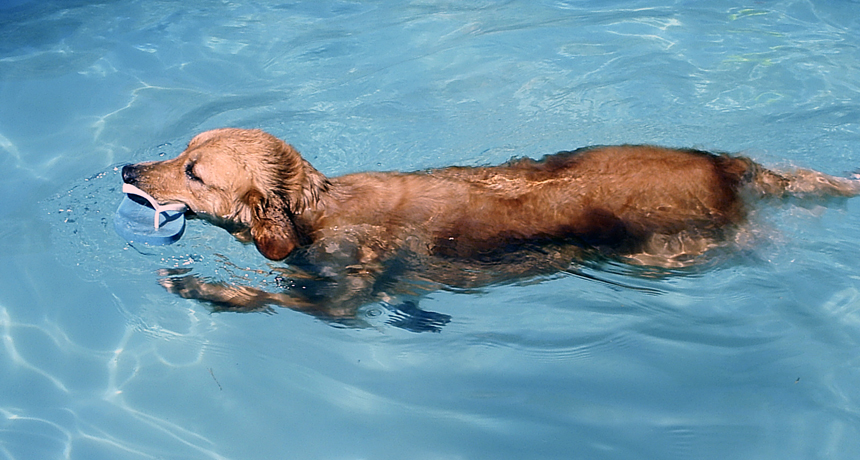Dissecting the dog paddle
Videos confirm that different types of dogs swim the same way

The first scientific study of the dog paddle shows that canines don’t trot in the water. Instead they make motions that more closely resemble a frantic run.
dmoca/istockphoto
For a recent experiment, scientists used eight dogs, a video camera, scuba gear, a swimming pool and a fish tank. Their goal: the first scientific analysis of the dog paddle. In the end, Pennsylvania researchers showed that all dogs seem to swim the same way. And, by the way, none of them “trotted” underwater.
People sometimes describe the dog paddle as a trot. But a close look shows it’s not, Frank Fish reported Jan. 5 at a science conference in Austin, Texas. A biologist at West Chester University in Pennsylvania, Fish admitted that he too used to describe dog paddling that way. During a trot, one front paw moves up and down in sync with the rear paw on the opposite side of the animal. But Fish and a coworker find that dogs don’t really swim that way.
The scientists studied eight dogs of six different breeds. These included Fish’s Nova Scotia duck tolling retriever, a German shepherd and a Yorkshire terrier. Fish donned scuba gear to film the dogs’ legs underwater as they swam in a pool or in water tanks at veterinary hospitals. (The tiny terrier fit in a long fish tank in Fish’s lab, so no scuba gear was needed.)
The video footage showed that when dogs swim, their diagonally opposite paws don’t move in tight sync. The timing of their leg motions followed a more complicated pattern. As such, the motions of a swimming dog look more like a different type of run. And dogs from all six breeds swam this way.
When swimming, a dog stretches out a paw and sweeps it down and back, which pushes the body forward. After that motion, the leg moves in close to the body. That way, as the leg moves forward for the next stroke, it doesn’t slow the animal down too much.
In spite of that, the movement is not particularly efficient. But it works well enough for the pooches. And understanding the dog paddle isn’t just a matter of scientific curiosity. This canine maneuver may help scientists better understand other mammals as well. Marine mammals like dolphins and whales swim gracefully, but scientists think the distant ancestors of these animals walked across land on four legs — like dogs.
Of course, dogs aren’t the only legged swimmers. Krill are tiny crustaceans that live in the ocean. Despite their size, they can swim relatively long distances, notes Jeannette Yen. An ecologist at the Georgia Institute of Technology in Atlanta, she directs a laboratory that tries to make technologies that mimic aspects of biology, including animal motion. Krill have five pairs of swimming legs. And unlike dogs, she told Science News, krill move theirs in a gracefully coordinated sequence — one that efficiently shoots them through the water.
Power Words
biology The study of living things. The scientists who study them are known as biologists.
breed Animals within the same species that are so genetically similar that they produce reliable and characteristic traits. German shepherds and dachshunds, for instance, are examples of dog breeds.
crustaceans Hard-shelled, water-dwelling animals including lobsters, crabs and shrimp.
ecology A branch of biology that deals with the relations of organisms to one another and to their physical surroundings. A scientist who works in this field is called an ecologist.







